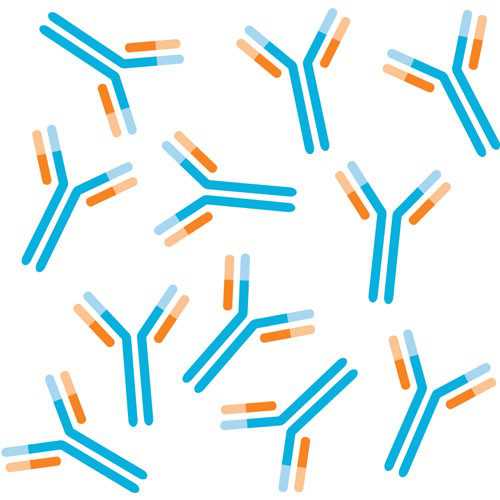Anti-Hydroxysteroid (17-beta) Dehydrogenase 7 Antibody
This IgG antibody was generated using microsomal fractions purified from pregnant rat corpus luteum d14 is specific for rat, mouse, human, cow, and hamster 17-beta-hydroxysteroid dehydrogenase 7 (HSD17B7).
17-beta-hydroxysteroid dehydrogenase 7 (HSD17B7) is involved in steroid biosynthesis, functioning in estrogen biosynthesis by converting weak estrogen to potent estradiol. A second function is in cholesterol biosynthesis responsible for conversion of zymosterol from lanosterol: step 5/6. Responsible for the reduction of the keto group on the C-3 of sterols.
From the laboratory of Geula Gibori, PhD, University of Illinois at Chicago.
 Part of The Investigator's Annexe program.
Part of The Investigator's Annexe program.
This IgG antibody was generated using microsomal fractions purified from pregnant rat corpus luteum d14 is specific for rat, mouse, human, cow, and hamster 17-beta-hydroxysteroid dehydrogenase 7 (HSD17B7).
17-beta-hydroxysteroid dehydrogenase 7 (HSD17B7) is involved in steroid biosynthesis, functioning in estrogen biosynthesis by converting weak estrogen to potent estradiol. A second function is in cholesterol biosynthesis responsible for conversion of zymosterol from lanosterol: step 5/6. Responsible for the reduction of the keto group on the C-3 of sterols.
From the laboratory of Geula Gibori, PhD, University of Illinois at Chicago.
 Part of The Investigator's Annexe program.
Part of The Investigator's Annexe program.
| Product Type: | Antibody |
| Antigen: | Gene name: Hydroxysteroid dehydrogenase 17beta, type 7 Protein name: 3-keto-steroid reductase |
| Accession ID: | O88736, Q62904, P56937, NM_010476 |
| Molecular Weight: | Approximately 33kDa (predicted molecular weight: 38 kDa) |
| Isotype: | IgG |
| Clonality: | Polyclonal |
| Clone Name: | HSD17B7 |
| Reactivity: | Rat, Mouse, Human, Cow, Hamster |
| Immunogen: | Microsomal fractions purified from pregnant rat corpus luteum d14 and mixed with Freund's adjuvant to stimulate immunity |
| Species Immunized: | Rabbit |
| Buffer: | Serum |
| Tested Applications: | WB (1:10,000), ELISA, IHC ( 1:250) |
| Storage: | -80C long term |
| Shipped: | Cold packs |
Generation of HSD17B7 polyclonal antibody.

A, Expression of His-tagged HSD17B7 in bacteria. Cells were grown in culture and induced to express His-HSD17B7 with increasing doses of IPTG. His-HSD17B7 proteins were purified on Talon column. The different fractions obtained were run on SDS-PAGE and stained with Coomassie blue dye. Fraction number denotes individual eluates obtained via sequential elution. These eluted proteins were used to generate antibodies in two rabbits. B and C, Western blot analysis was performed with serially diluted antibodies from first (B) and fourth bleed (C) using proteins from corpora lutea known to highly express HSD17B7. D, Immunoprecipitation of luteal HSD17B7 with the two antibodies generated to native HSD17B7 protein.
Adapted from: Shehu A, Albarracin C, Devi YS, Luther K, Halperin J, Le J, Mao J, Duan RW, Frasor J, Gibori G. The stimulation of HSD17B7 expression by estradiol provides a powerful feed-forward mechanism for estradiol biosynthesis in breast cancer cells. Mol Endocrinol. 2011 May;25(5):754-66.
Tissue Specificity: Most abundant in ovaries of pregnant animals, specifically in corpus luteum of pregnancy. Present also in non-pregnant animals in ovaries (follicles), placenta, breast cancer, mammary gland, liver, kidney, testis and MCF-7 cell line.
Alternative names: 17 beta HSD 7 antibody, 17 beta hydroxysteroid dehydrogenase 7 antibody, 17 beta hydroxysteroid dehydrogenase type VII antibody, 17-beta-HSD 7 antibody, 17-beta-hydroxysteroid dehydrogenase 7 antibody, 17beta hydroxysteroid dehydrogenase antibody, 3 keto steroid reductase antibody, 3-keto-steroid reductase antibody, DHB7_HUMAN antibody, Estradiol 17 beta dehydrogenase 7 antibody, Estradiol 17-beta-dehydrogenase 7 antibody, Hsd17b7 antibody, hydroxysteroid (17 beta) dehydrogenase 7 antibody, MGC12523 antibody, MGC75018 antibody, PRAP antibody, SDR37C1 antibody, Short chain dehydrogenase/reductase family 37C member 1 antibody
- Shehu A, Albarracin C, Devi YS, Luther K, Halperin J, Le J, Mao J, Duan RW, Frasor J, Gibori G. The stimulation of HSD17B7 expression by estradiol provides a powerful feed-forward mechanism for estradiol biosynthesis in breast cancer cells. Mol Endocrinol. 2011 May;25(5):754-66.
- Duan WR, Parmer TG, Albarracin CT, Zhong L, Gibori G.PRAP, a prolactin receptor associated protein: its gene expression and regulation in the corpus luteum. Endocrinology. 1997 Aug;138(8):3216-21.
- Duan W.R., Linzer D.I.H., Gibori G. Cloning and characterization of an ovarian-specific protein that associates with the short form of the prolactin receptor.J. Biol. Chem. 271:15602-15607(1996).
- Parmer TG, McLean MP, Duan WR, Nelson SE, Albarracin CT, Khan I, Gibori G.Hormonal and immunological characterization of the 32 kilodalton ovarian-specific protein. Endocrinology 1992 Nov;131(5):2213-21.
If you publish research with this product, please let us know so we can cite your paper.


